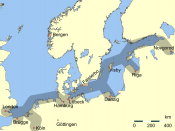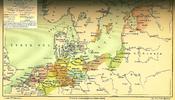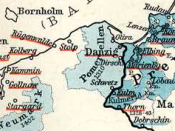Hanseatic League
The Hanseatic League was not so much a league of cities as it was a league of merchant associations within the cities of Northern Germany and the Baltic. Trade in the middle ages was a dangerous and risky business and the only way for merchants to protect themselves was by travelling together. This banding together of merchants on the road led to their alliances at home as well. The Hansa was founded in the twelfth century by an alliance between the northern towns of Hamburg and Luebeck which lay on opposite sides of the base of the Danish peninsula. Luebeck was in a position to capitalize on a large commodities market in herring, but one thing held Luebeck back. With no refrigeration or canning the shipping of a highly perishable commodity like fish was problematic. Hamburg, on the other side of the Jutland peninsula, had easy access to the salt produced in the salt mines at Kiel, and salting and drying of meat and fish made transport and distribution possible.
It was in the interest, then, for the merchants of these two towns to open trade along the canal that was made between them, a canal which came to be known as the Kiel canal because Kiel was the source of the salt that travelled through it. While each city had its own merchant association the alliance formed a loose Diet, or parliament, to govern inter-city trade and common policies. In most respects the policy of the merchants was protectionist and aimed at producing a German monopoly in the markets they supplied. There was a Rhennish third based on the Rhine trade, a Wendish third based on Baltic shipping out of Luebeck, and a Prussian third based on the trade of grain from the lands of the Teutonic Order. Almost all trade to the Baltic, either coming or going, went through the port of Luebeck. The cargos in the port of Luebeck consisted of salt, herring, grain, timber, honey, amber, ships stores, and other bulk commodities. Because of the dangers involved with shipping cargos, especially since there was no such thing as insurance, the common practice was to form partnerships and have each merchant buy a share of a cargo or a share of a ship. By spreading your investment over several cargos and shipping them on several ships the risk of a catastrophic loss was reduced.Cities: Bergen, Bruges, Hamburg, Lubeck-most powerful, Bostock, Danzig, Riga, Novgorod
The Teutonic order
The teuronic order was a crusading order of knights under Roman Catholic religious vows which was formed at the end of the 12th century in Palestine to give medical aid to pilgrims to the holy places. They received Papal orders for crusades to take and hold Jerusalem for Christianity. When the mission of the order in Palestine was nearing its end, the Teutonic Knights moved their headquarter to Venice. Despite the fact, that their mission of conquering the Holy land was ended, they wanted to introduce the idea of religious crusades to Eastern Europe, on the border with pagan nations. The Knights offered their services to the local Christian rulers posing as religiously motivated mercenaries. Nevertheless, they hoped that using their influence in the Holy Roman Empire could help them become territorial proprietors of the newly conquered lands. The Order ruled over much of the Baltic for several centuries, losing power during the late Middle Ages with the rise of the Poland. The Order became involved in a series of wars against Poland and Lithuania. In 1454 gentry and the burghers of western Prussia rose up against the Order in the "War of the Cities" or Thirteen Years War, at the end of which the order recognized the Polish crown rights over Prussia's western half (subsequently Royal Prussia) while retaining eastern Prussia under nominal Polish overlordship (Second Treaty of Thorn, 1466).


